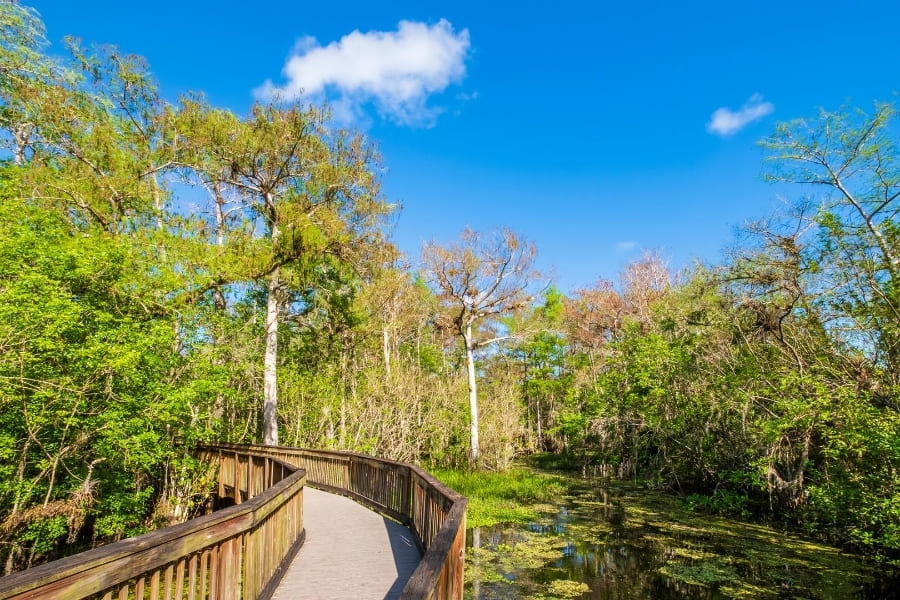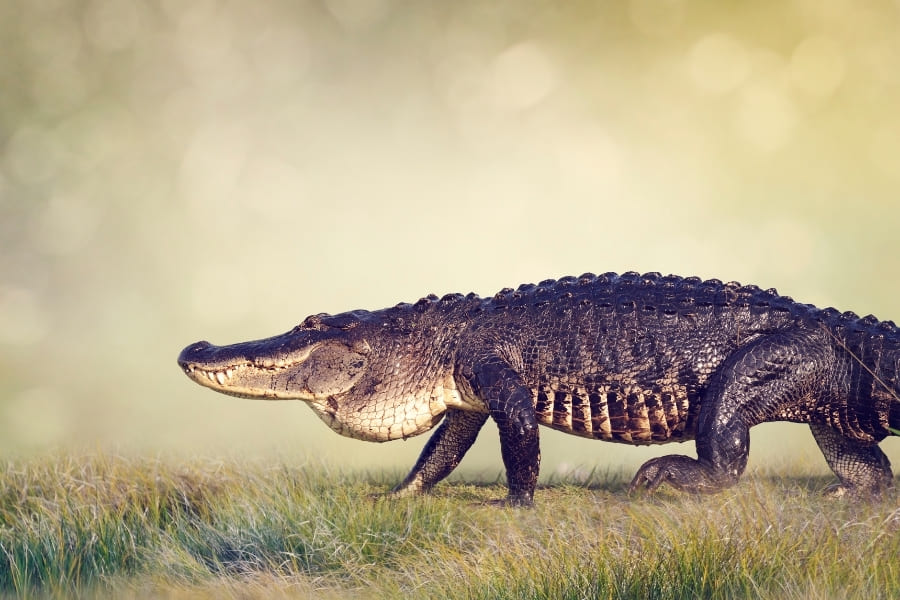From wide, open prairies to pristine mangrove forests, from the rippling waters of the Turner River to the last cypress forests in North America – There is hardly a place in the U.S. that can match the diversity of the Big Cypress National Preserve. If you want to see Florida’s iconic animals like alligators, manatees, turtles, waterfowl, and even panthers, this is THE place to go.
Just as diverse as the flora and fauna are the activities in this green paradise: Whether on relaxing strolls or adventurous swamp tours, whether by bike, kayak or off-road vehicle – there is always something to discover in the Big Cypress National Preserve.
We will show you what makes this protected area east of Naples so special, what kinds of animals and plants you can see here, and which places are particularly worth-while for a trip.
Big Cypress National Preserve – important Facts
History, geography, flora and fauna as well as important places for visitors – in the following section, you will find the most important facts about the Big Cypress National Preserve:
History
Prior to the arrival of European settlers, the area was inhabited by Semiole and Mikasuki Indians. After being used for hunting in the 19th and oil drilling in the 20th century, Big Cypress National Preserve was declared a protected area in 1974. Later, 232 square miles of land were added to the preserve, and the touristic infrastructure was further developed.
Location and Climate
The Big Cypress National Preserve stretches between Naples and Miami, which places it right in the middle between South Florida´s two coasts. In total, the preserve covers an area of 1,126 square miles.
Typically for South Florida, the climate is dominated by the change between dry and rainy season. From November to May, there are mild temperatures and moderate precipitation. In summer and autumn, temperatures reach 34° C and heavy rainfall causes floodings in large parts of the preserve. During this time, visitors should expect inaccessible paths, high humidity and swarms of mosquitoes – but they are rewarded with the sight of blooming wildflowers.
Plants
The Big Cypress National Preserve features an astonishingly diverse flora. One key feature are its extensive cypress forests – hence the name. In addition, the area is dominated by mangroves, grassy prairies and forested islands called “hammocks”. More than 800 species of plants are found in the preserve – almost as many as in the much larger Everglades National Park. A particularly colorful sight are 36 orchid species that grow both on soil and on tree trunks.
Animals
Given the wide variety of landscapes, it is not surprising that the Big Cypress National Preserve provides refuge for numerous animals: these include waterbirds such as herons, anhingas and ibises, as well as turtles, frogs, snakes and alligators. Otters, lynxes and black bears live well hidden in the undergrowth, and even more luck is needed if you want to see the rare Florida panther: Only 30–35 specimens roam the huge area of the Big Cypress National Preserve. A more frequent guest are Manatees: Florida’s iconic “sea cows” can be seen on the coast, but also in the canals of the preserve – especially in winter, when the animals seek shelter in the warm water.
Visitor Centers
Most guests of the Big Cypress National Preserve start their trip at two visitor centers that are open year-round (except for Christmas). Both are located right next to the Tamiami Trail Highway and feature exhibits on the flora and fauna, but also on the history of the preserve. In addition, you will find gift shops with souvenirs such as books, DVDs, postcards, T-shirts and mugs.
Adresses: .
| Nathaniel P. Reed Visitor Center | Oasis Visitor Center |
| 33000 Tamiami Trail East Ochopee, Florida 34141 239-695-4758 |
52105 Tamiami Trail East Ochopee, Florida 34141 239-695-4111 |
Big Cypress National Preserve Map
Do you want to see where the Big Cypress National Preserve begins, which road you should take, and where the visitor centers are located? Then, this map will help you.
Big Cypress National Preserve – popular Activities
Whether on water or on land, solo or with expert guides – the following activities are particularly popular in the Big Cypress National Preserve:
Hiking
The Big Cypress National Preserve offers both short strolls and long-distance hikes. If you are looking for a comfortable experience, we recommend the wooden boardwalk next to the Oasis Visitor Center. Here, you can overlook a pond that is populated by alligators. The 4,3-mile-long Gator Hook Trail is another easy route for beginners. Please note, however, that the paths of the preserve are flooded for several months of the year. Thus, if you want to avoid wet feet, the dry season between November and May is your best friend.
Are you wondering what secrets await beyond the official hiking paths? Then, a “Swamp Walk” at Big Cypress National Preserve is perfect for you. Armed with rubber boots and a mosquito net, you will follow your guide into the flooded swampland — a place not many visitors get to see. Here, no noises disturb the peace, except for murmuring creeks and the croaking of frogs. This makes every Swamp Walk a truly serene and meditative experience.
Swamp Buggy Tours
With their huge tires, the swamp buggies of the Big Cypress National Preserve may look intimidating at first sight. However, many visitors agree: There is no better way to comfortably explore this wilderness. Depending on the provider, up to 6 people can take a seat on these all-terrain vehicles. Not only do the Swamp Buggies provide perfect vantage points for observing and photographing animals. Experienced guides will also tell you interesting stories about the flora and fauna of the Big Cypress National Preserve.
Kayaking
If you want to explore the extensive waterways of the Big Cypress National Preserve, a kayak is your best choice. Especially popular is the Turner River Paddling Trail, which starts right next to Highway 41, leads 10 miles through the protected area and even cuts into Everglades National Park. Slightly shorter, but even more varied is the Lefthand Turner River Paddling Trail starting in Everglades City. After a 3-mile-long ride along flooded prairies and mangrove forests, the trail terminates at Chokoloskee Island, a truly picturesque place off the coast.
Biking
If you are looking for a balanced mix of exercise and natural scenery, you should explore the Big Cypress National Preserve by bike: either along the historic Tamiami Trail or on one of the designated bike paths. Especially beginner-friendly is the Fire Prairie Trail: a 5-mile-long dirt road where you can marvel at the vastness of South Florida’s grasslands. Or are you looking for a challenge off the beaten track? Then, the off-road trails of the preserve are perfect for you.
Fishing
Fishing is allowed in all lakes, ponds, and rivers of the Big Cypress National Preserve. Although no special permit from the national park is required, visitors still need a State Fishing License. With this license, you will be ready to catch more than 60 species of fish – including eels, catfish, sea brass and snapper.
Camping
There is a lot to discover in the Big Cypress National Preserve – too much for just one day. Luckily, camping is allowed at 8 official campgrounds that are equipped with toilets and charge 10–30 USD per night. If you are looking for a true adventure, you should try Backcountry Camping: Off the beaten track, hikers can pitch their tents for free. All you need to do is fill out a permit – either online or at the visitor centers.
Hunting
It may come as a surprise to foreign visitors – but hunting certain animals is allowed in the Big Cypress National Preserve: these species include deer, wild boar, turkeys, squirrels, quails, hares, raccoons and coyotes. However, hunters have to register at one of the Hunter Check-In Stations along Highway 41 and State Road 93.
Scenic Routes for Motorists
You do not have the time for long hikes or boat trips, but still want to experience the beauty of the Big Cypress National Preserve? No problem. You can also do so by car. Particularly popular is the Loop Road: a junction of the Tamiami Trail that runs for 27 miles along cypress forests and open grasslands; Alternatively, you can turn north onto Turner River Road. This route runs parallel to a canal, where many species of waterbirds can be spotted.
Off-road Rides
Motorists who want to venture deeper into the heart of the Big Cypress National Preserve must leave the roads behind and bring an all-terrain vehicle. This way, you can explore unpaved routes, of which there are plenty in the Preserve. Please note, however, that you need to obtain an Offroad Permit that includes both an online safety course and the inspection of your vehicle. You can get the permit at the headquarters of the Preserve (33100 Tamiami Trail East. Ochopee, FL 34141).
FAQ – Frequently Asked Questions
How big is the Big Cypress National Preserve?
The Big Cypress National Preserve is located in the heart of South Florida. With an area of 1,126 square miles, its size is similar to the state of Rhode Island.
When was the Big Cypress National Preserve established?
The Big Cypress National Preserve was established as a protected area on October 11, 1974.
What is the entrance fee for Big Cypress National Preserve?
Admission to the preserve itself is free. Fees only apply for campsites and special permits: for example, if you want to explore the area with an off-road vehicle.
What is there to do at Big Cypress National Preserve?
The Big Cypress National Preserve provides numerous opportunities for hiking, cycling and kayaking, fishing and hunting, as well as off-road trips and Swamp Buggy tours. In addition, there are two visitor centers with interesting exhibits about the preserve.







